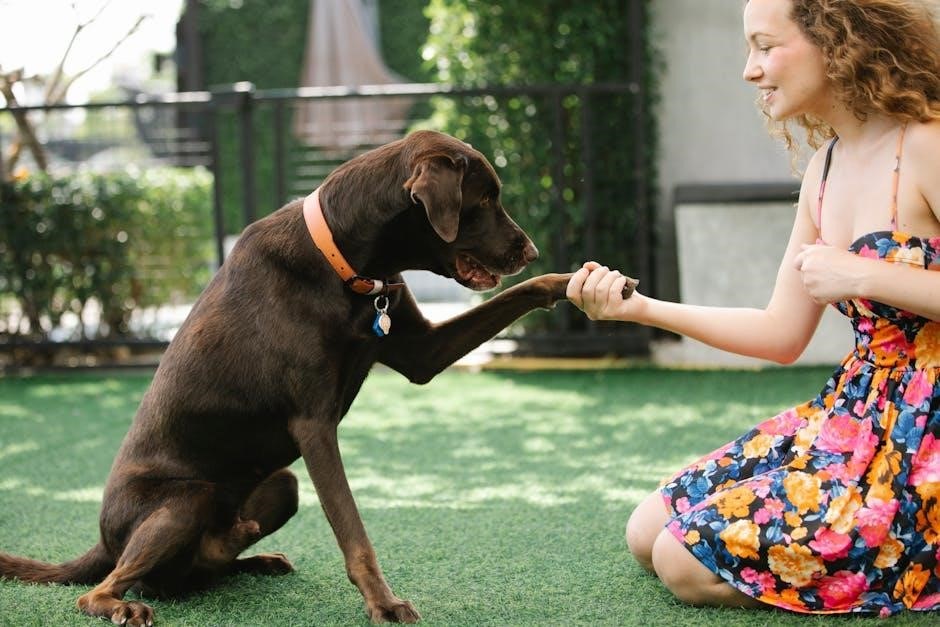Discover the essentials of dog training with a comprehensive guide‚ featuring full-color photos and detailed steps. Learn to establish routines‚ teach commands‚ and address behavior challenges effectively.
Understanding the Importance of Dog Training
Training is essential for building a strong bond with your dog‚ ensuring their safety‚ and fostering good behavior. It helps dogs understand boundaries and respond to commands‚ reducing unwanted habits; A well-trained dog is less likely to encounter dangerous situations and interacts better with people and other animals. Training also provides mental stimulation‚ preventing boredom and stress. By investing time in training‚ you create a foundation for a well-behaved‚ confident‚ and loyal companion. It’s a crucial step in raising a happy‚ healthy‚ and well-adjusted dog.
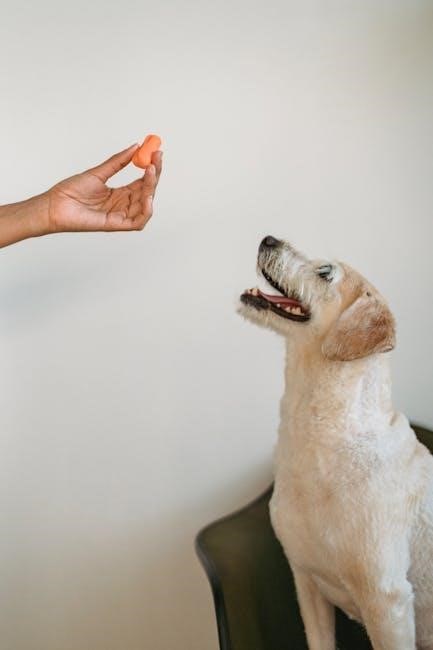
Setting Realistic Goals for You and Your Dog
Setting realistic goals is key to successful training. Start with simple‚ achievable objectives that match your dog’s age‚ breed‚ and ability. Short‚ frequent sessions yield better results than lengthy‚ overwhelming ones. Celebrate small victories to keep motivation high. Tailor goals to your lifestyle and your dog’s personality. Consistency and patience are vital. By setting clear‚ attainable milestones‚ you create a structured learning path for your dog‚ ensuring steady progress and a positive experience for both of you.
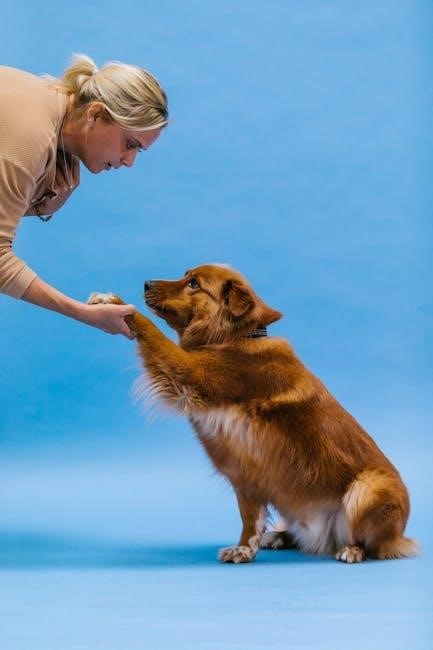
Preparation for Dog Training
Begin by gathering essential supplies and reading the training manual. Understand the methods and prepare a structured plan for effective sessions with your dog;
Essential Supplies for Effective Training
Gather necessary items like leashes‚ collars‚ and high-value treats to aid in positive reinforcement. A crate is crucial for housebreaking and providing a safe space. Choose durable toys and pads for comfort. Ensure all supplies are appropriate for your dog’s size and breed to promote effective learning and safety. These tools will help create a structured and productive training environment for both you and your dog;
Creating a Positive Learning Environment
A positive learning environment is key to successful dog training. Ensure your dog feels safe and focused by minimizing distractions. Use positive reinforcement techniques like treats and praise to encourage good behavior. Consistency and patience are vital‚ as dogs thrive on routine. Create a calm atmosphere where your dog can concentrate and enjoy the process. Tailor your approach to your dog’s personality and learning style for the best results. A happy and stress-free environment fosters trust and accelerates the learning process.
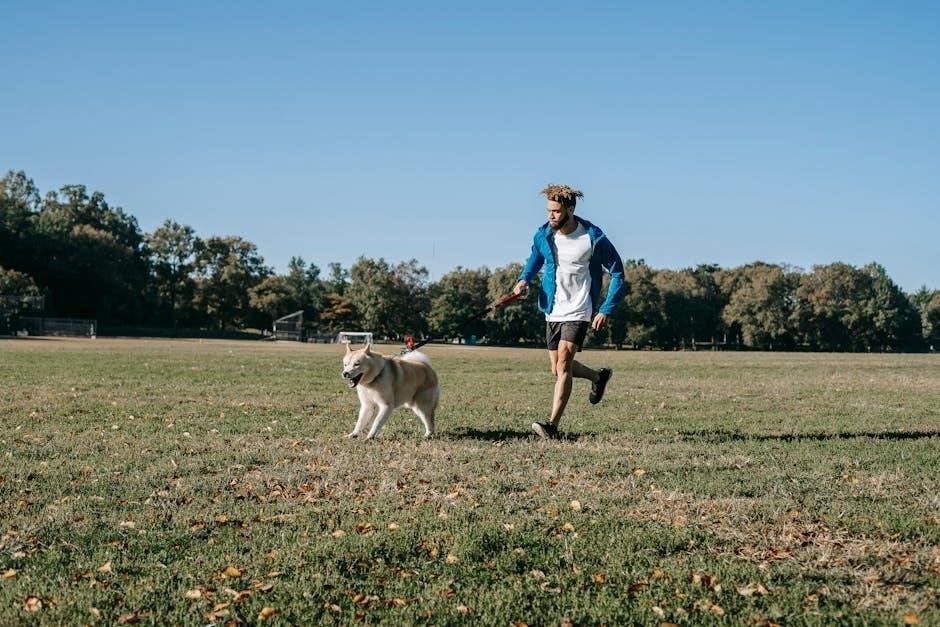
Crate Training Your Puppy
Crate training is a useful tool for housebreaking and provides a safe space for your puppy‚ but avoid overuse to prevent stress and discomfort.
Benefits of Crate Training for Housebreaking
Crate training is an effective tool for housebreaking‚ as dogs naturally avoid soiling their immediate environment. It helps prevent accidents when unsupervised‚ making the process faster and less stressful. By confining your puppy to a crate when you’re not home‚ you can better control their bathroom habits and establish a consistent routine. This method also helps with potty training by giving your puppy a safe space to relax without the risk of accidents. Over time‚ your puppy will learn to hold their bladder and bowels‚ leading to better behavior and fewer cleanup efforts.
Introducing the Crate to Your Puppy
Begin by placing the crate in a common area‚ like the living room‚ with the door open. Make it inviting with treats or toys to encourage exploration. Start by letting your puppy enter voluntarily‚ then gradually close the door while you’re nearby. Begin with short periods‚ such as 5-10 minutes‚ and reward calm behavior. Avoid using the crate as punishment‚ as this could create negative associations. Always supervise your puppy during crate introduction to ensure a positive experience. Over time‚ your puppy will view the crate as a safe‚ comforting space.
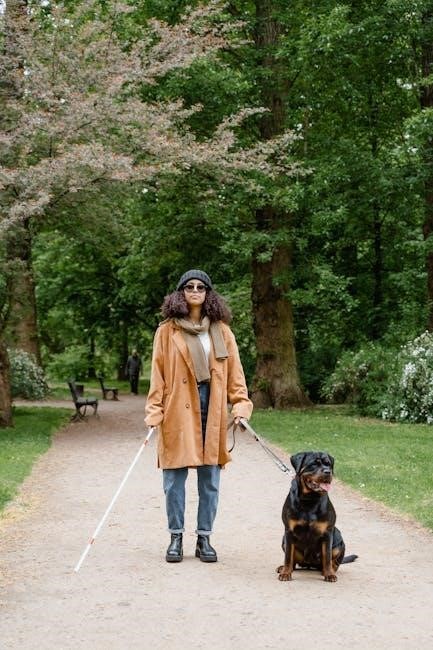
Basic Command Training
Master essential commands like “sit‚” “stay‚” and “come.” Use positive reinforcement and clear signals to build a strong foundation for effective communication with your dog.
Teaching Fundamental Commands Like “Sit” and “Stay”
Start with simple commands like “sit” and “stay.” Use treats and praise to encourage good behavior. Hold a treat above your dog’s head and move it backward to help them sit. Gradually increase the duration for “stay.” Be patient and consistent‚ as these commands form the basis for more complex training. Positive reinforcement ensures your dog associates learning with positive outcomes‚ making the process enjoyable and effective for both you and your pet. Clear communication and repetition are key to success. Over time‚ your dog will master these essential skills.
Using Positive Reinforcement Techniques
Positive reinforcement is a powerful method that focuses on rewarding desired behaviors. Use treats‚ praise‚ or affection to encourage good actions‚ creating a positive learning environment. Timing is crucial—reward the exact moment your dog performs the correct behavior. Consistency is key‚ so ensure everyone uses the same cues and commands. Over time‚ phase out treats as your dog learns‚ using them only for exceptional effort. This approach builds trust‚ reduces anxiety‚ and fosters a strong bond‚ making training enjoyable and effective for both you and your dog. It’s a cornerstone of successful dog training.
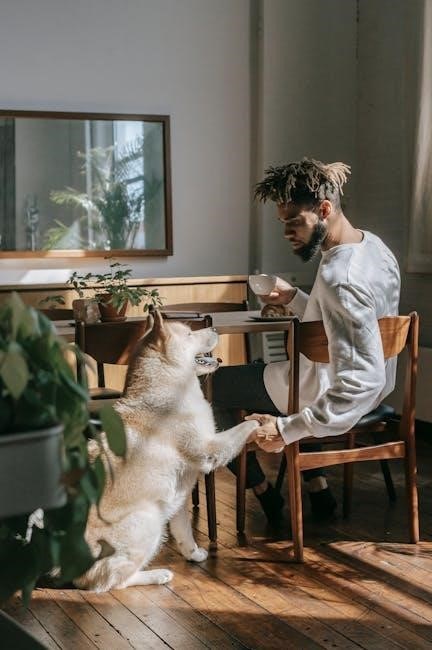
House Training Strategies
Effective house training relies on consistency and positive reinforcement. Use crates to prevent accidents‚ as dogs avoid soiling their immediate environment; Establish a daily routine for feeding and outdoor breaks to create predictable patterns‚ making it easier for your dog to learn. Supervise closely and reward successful efforts to reinforce good habits. Over time‚ your dog will understand and follow the house rules‚ leading to a cleaner and happier home environment. Patience and persistence are key to achieving long-term success.
Establishing a Consistent Routine
A consistent routine is the cornerstone of successful house training. Start by creating a schedule for feeding times‚ outdoor breaks‚ and play sessions. Dogs thrive on predictability‚ and a structured routine helps them learn when it’s time to eat‚ play‚ and relieve themselves. Use crates to manage time effectively‚ as dogs naturally avoid soiling their immediate environment. Supervise your dog closely during training to quickly address accidents and reinforce good behavior; Over time‚ your dog will adapt to the routine‚ reducing the likelihood of accidents and speeding up the training process.
Handling Accidents and Setbacks
Accidents are inevitable during house training‚ but how you respond matters. Stay calm and avoid punishing your dog‚ as this can create fear. Instead‚ clean up thoroughly to remove any lingering scents that might attract your dog to the same spot again. Use a crate to manage your dog during times when close supervision isn’t possible. Setbacks are normal‚ so don’t discourage. Focus on consistency and positive reinforcement to help your dog overcome challenges and continue progressing in their training journey.
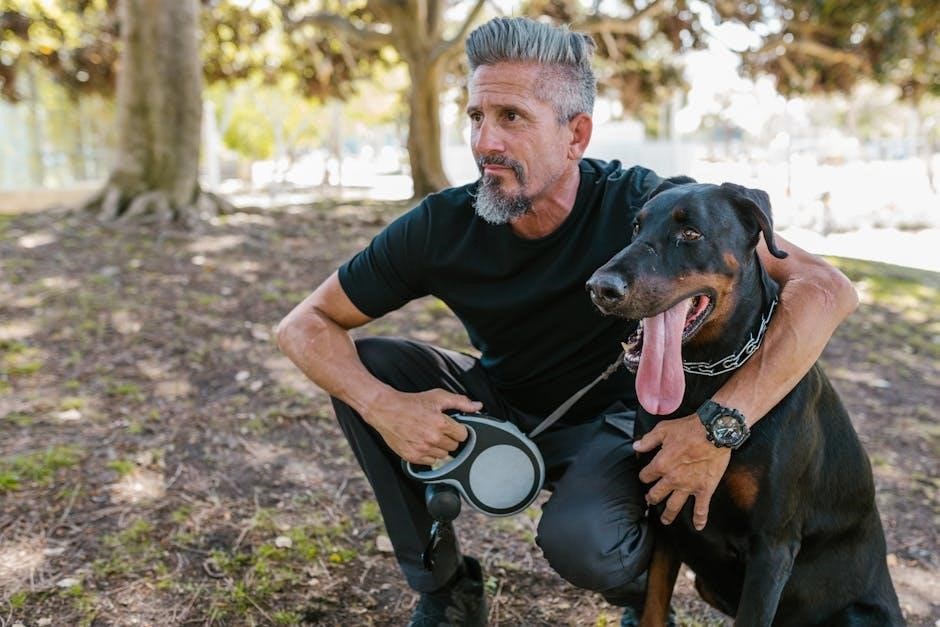
Socialization and Advanced Training
Enhance your dog’s social skills and refine their abilities through advanced techniques. Explore training in diverse environments and learn strategies to adapt to various challenges effectively.
Why Socialization is Crucial for Your Dog
Socialization is a cornerstone of dog training‚ helping your pet interact confidently with people‚ other animals‚ and new environments. Proper socialization reduces anxiety and aggression‚ fostering a well-adjusted dog. By exposing your dog to diverse experiences‚ you prepare them for real-world situations. Positive interactions during this critical period ensure your dog grows into a friendly and calm companion. A well-socialized dog is easier to train and less likely to develop behavioral issues later in life. This foundation is vital for their emotional and psychological well-being.
Training in Different Environments
Training your dog in various environments is essential for building adaptability and reliability. Expose your dog to urban‚ rural‚ and indoor settings to help them generalize commands. Different locations introduce new distractions‚ such as noise‚ people‚ and other animals‚ which strengthen your dog’s ability to focus. Start with familiar areas and gradually introduce more challenging environments. This approach ensures your dog responds consistently‚ regardless of the setting. Varying environments also prevents overreliance on a single location‚ making your dog more versatile and responsive in real-life situations. This diversity in training fosters confidence and obedience.
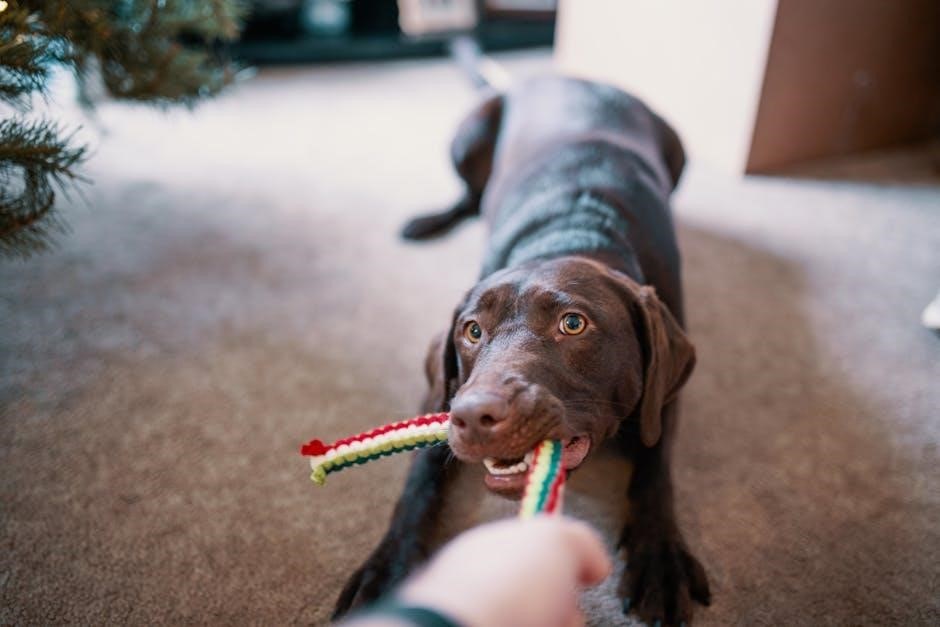
Addressing Behavioral Issues
Identify and tackle unwanted behaviors early to promote a well-adjusted dog. Consistent corrections and positive reinforcement help break bad habits‚ fostering a calm and obedient companion.
Common Challenges and Solutions
Every dog owner faces challenges‚ such as excessive barking‚ chewing‚ or digging. Consistency is key—redirect unwanted behavior with positive reinforcement. For example‚ reward calmness to reduce barking. Crate training can help with housebreaking by giving your dog a safe space‚ preventing accidents. When addressing bad habits‚ avoid punishment and focus on reinforcing good behavior. Time-outs in crates can serve as a gentle correction. Stay patient and persistent‚ as breaking habits takes time. With the right approach‚ you can help your dog become a well-adjusted‚ obedient companion.
Breaking Bad Habits in Dogs
Breaking bad habits in dogs requires patience and consistency. Start by identifying triggers that lead to unwanted behavior. Use positive reinforcement to reward good conduct‚ distracting your dog with treats or toys when they exhibit bad habits. Crate training can help manage habits like chewing by providing a safe‚ controlled space. Consistency is key—ensure all family members follow the same training approach. With persistence and the right techniques‚ you can help your dog overcome bad habits and develop better behaviors over time.
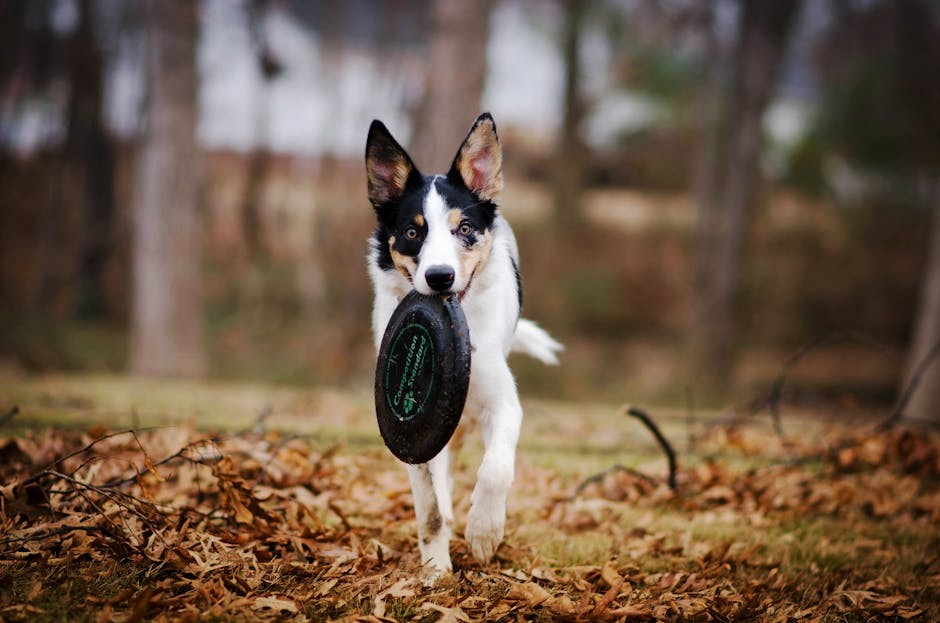
Advanced Dog Training Techniques
Explore intermediate commands and breed-specific strategies. Learn techniques for training in diverse environments to enhance your dog’s adaptability and obedience.
Intermediate Commands and Tricks
Mastering intermediate commands like “heel‚” “stay close‚” and “figure-eights” enhances your dog’s obedience and agility. Tricks such as “spin” and “roll over” add fun and mental stimulation. These exercises refine coordination and focus‚ preparing your dog for more complex tasks. Incorporate positive reinforcement to encourage quick learning and build confidence. Training in varied environments strengthens adaptability‚ ensuring your dog responds reliably in any setting. This phase lays the groundwork for advanced training and deepens the bond between you and your dog.
Training for Specific Breeds
Different dog breeds have unique traits‚ requiring tailored training approaches. For example‚ working breeds like German Shepherds thrive on mental and physical challenges‚ while smaller breeds like Pugs may need shorter‚ gentler sessions. Understanding your breed’s instincts‚ energy levels‚ and temperament helps customize training. Positive reinforcement techniques work across breeds but should be adapted to their responsiveness. Tailoring exercises to suit a breed’s natural behaviors ensures effective learning and strengthens the bond between you and your dog. This personalized approach fosters confidence and resilience in any breed.
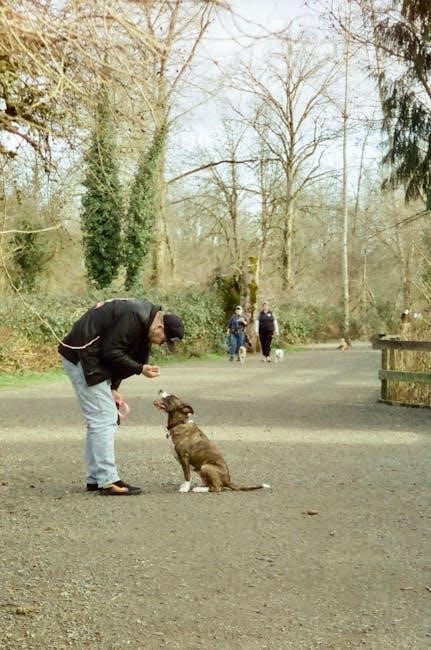
Resources for Dog Owners
Explore recommended dog training manuals and free e-books offering tips‚ strategies‚ and guides for various needs‚ from family pets to service dogs. Download PDFs for expert advice.
Recommended Dog Training Manuals and Guides
A comprehensive dog training manual‚ such as the New Complete Dog Training Manual‚ offers beautifully illustrated guides with detailed steps for establishing routines‚ teaching commands‚ and breaking bad habits. These resources are tailored for various needs‚ from family pets to service dogs. They provide expert advice on understanding your dog’s behavior‚ implementing positive reinforcement‚ and addressing breed-specific challenges. Whether you’re a novice or an experienced owner‚ these manuals are invaluable for fostering a well-behaved and obedient companion. They emphasize practical‚ real-world applications‚ making them a must-have for effective training.
Free Dog Training E-Books and PDFs
Explore a wealth of free dog training e-books and PDFs designed for every need‚ from family pets to service dogs. These resources cover topics like basic obedience‚ housebreaking‚ and advanced techniques. Many e-books are tailored to specific breeds or training goals‚ offering practical tips and strategies. Websites like Official Dog Trainers and Puppy Training Pro provide accessible guides. Download these free materials to enhance your training journey and help your dog become a well-behaved companion. They’re perfect for busy owners seeking affordable‚ high-quality training advice.
Consistent training and positive reinforcement build a strong bond with your dog‚ fostering trust and understanding. Stay committed to your dog’s growth for lifelong companionship and happiness.
Final Tips for Successful Dog Training
Consistency and patience are key to effective dog training. Always end sessions on a positive note to reinforce good behavior and strengthen your bond. Celebrate small victories to keep motivation high for both you and your dog. Remember‚ every dog is unique‚ so tailor your approach to suit their personality and learning style. Stay patient‚ and with time‚ your efforts will yield a well-behaved and loyal companion.
Maintaining a Strong Bond with Your Dog
A strong bond with your dog is built on trust‚ respect‚ and clear communication. Spend quality time through play and shared activities to deepen your connection. Positive reinforcement during training strengthens this relationship‚ fostering loyalty and mutual understanding. Celebrate achievements and show affection to create a supportive environment. Consistency and patience help your dog feel secure‚ while active engagement keeps their mind and body stimulated. A strong bond not only enhances training success but also enriches your life together‚ creating a lifelong friendship;
